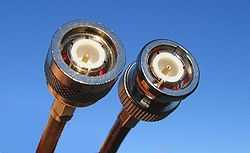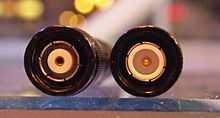TNC connector
 TNC connector on the left beside BNC. | |||
| Type | RF coaxial connector | ||
|---|---|---|---|
| Production history | |||
| Designer | Paul Neill and Carl Concelman | ||
| Designed | Late 1950s | ||
| Manufacturer | Various | ||
| General specifications | |||
| Diameter | Male: 0.590 in (15.0 mm) Female: 0.378 in (9.6 mm) (outer, typical) Thread 7/16-28 UNEF | ||
| Cable | Coaxial | ||
| Passband | Typically 0-11 GHz | ||
The TNC (Threaded Neill–Concelman) connector is a threaded version of the BNC connector. The connector has a 50 Ω impedance and operates best in the 0–11 GHz frequency spectrum. It has better performance than the BNC connector at microwave frequencies. Invented in the late 1950s and named after Paul Neill of Bell Labs and Carl Concelman of Amphenol, the TNC connector has been employed in a wide range of radio and wired applications.[1]
Variations
Reverse-polarity TNC

Reverse-polarity TNC (RP-TNC, sometimes RTNC) is a variation of the TNC specification which reverses the polarity of the interface. This is usually achieved by incorporating the female contacts normally found in jacks into the plug, and the male contacts normally found in plugs into the jack.[2]
Because they were not readily available, RP-TNC connectors have been widely used by Wi-Fi equipment manufacturers to comply with specific local regulations, such as those from the FCC,[3] which are designed to prevent consumers from connecting antennas which exhibit gain and therefore breach compliance. The FCC considered that the RP-TNC was acceptable in preventing consumers changing the antenna; but by 2000 it regarded them as readily available,[4] though delaying its ruling indefinitely.[5] As of 2013, leading manufacturers are still using RP-TNC connectors on their Wi-Fi equipment.[6]
75 ohm TNC
Most TNC connectors are 50-ohm type even when used with coaxial cable of other impedances, but a 75-ohm series is also available, providing a good SWR to about 1 GHz.[7] These can be recognized by a reduced amount of dielectric in the mating ends. They are intermatable with standard types.
Retail uses
Linksys, owned by Belkin,[8] a manufacturer of consumer networking equipment, uses RP-TNC connectors for several of its Wi-Fi-certified routers, including the popular WRT54G.
Telex Communications, a manufacturer of hearing aids and audio equipment, uses TNC connectors on its Radiocom BTR-800 partyline intercom base station for the transmit and receive antennas.
Camplex, a Camera multiplexing unit, uses TNC connectors to send power/tallies/intercom to a camera. The camera sends back audio, video, and intercom.[9]
Icom, a mobile telecommunications equipment manufacturer, uses TNC antenna output terminals in some models intended for the professional VHF PMR market.
Electro-Voice, a pro audio manufacturer, uses these style connectors on their wireless microphone systems.
See also
- RF connector
- SMA connector, SMB connector, SMC connector
- BNC connector, N connector
- Optical fiber connector
References
|
- ↑ E-Base Interactive. "TNC Connector Series". Amphenol RF. Retrieved 2011-01-12.
- ↑ "RP-TNC Connector".
- ↑ U.S. Code of Federal Regulations: 47 CFR 15.203, available at http://www.ecfr.gov
- ↑ FCC public notice, "OET clarifies antenna connector requirements for Part 15 Unlicensed Transmitters", http://hraunfoss.fcc.gov/edocs_public/attachmatch/DA-00-1087A1.pdf
- ↑ FCC public notice, "OET extends effective data of antenna connector requirement indefinitely" http://hraunfoss.fcc.gov/edocs_public/attachmatch/DA-00-2225A1.pdf
- ↑ Getting Started Guide: Cisco 3600 Series Access Points http://www.cisco.com/en/US/docs/wireless/access_point/3600/quick/guide/ap3600getstart.html#wp59090
- ↑ "HUBER+SUHNER TNC 75 Ohm series (EN)". Hubersuhner.com. 2010-10-28. Retrieved 2011-01-12.
- ↑ "Belkin completes acquisition of Linksys from Cisco". Retrieved 2014-06-16.
- ↑ "Innovation in Motion". Camplex. Retrieved 2011-01-12.